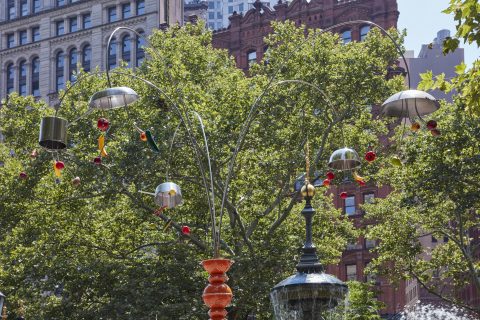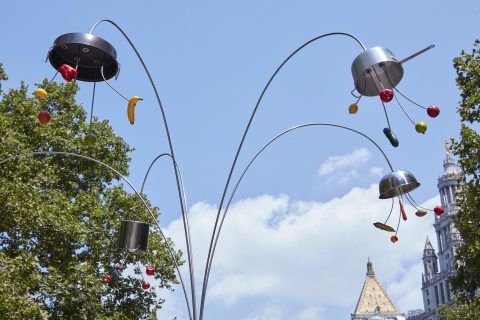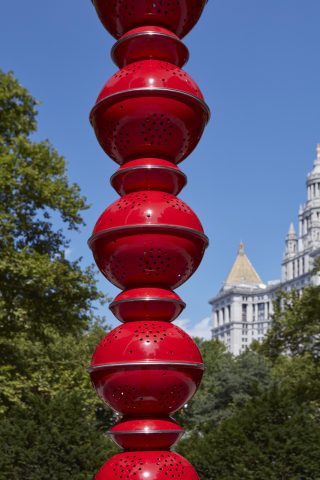B. Wurtz: how to rule over readymades and help art students (an interview)
On occasion of his New York’s Public Art Fund commission, B. Wurtz sheds some light on his interpretation of the score Duchamp wrote almost 100 years ago.
- B. Wurtz, Kitchen Trees, 2018. Stainless steel frame with powder coated colanders, aluminum and stainless steel pots and pans, and plastic fruits and vegetables. Courtesy of the artist; Metro Pictures, New York; Kate MacGarry, London; Maisterravalbuena Madrid/Lisboa; Richard Telles Fine Art, Los Angeles. Photo: Jason Wyche, Courtesy of Public Art Fund, NY.
- B. Wurtz, Kitchen Trees, 2018. Stainless steel frame with powder coated colanders, aluminum and stainless steel pots and pans, and plastic fruits and vegetables. Courtesy of the artist; Metro Pictures, New York; Kate MacGarry, London; Maisterravalbuena Madrid/Lisboa; Richard Telles Fine Art, Los Angeles. Photo: Jason Wyche, Courtesy of Public Art Fund, NY.
- B. Wurtz, Kitchen Trees, 2018. Stainless steel frame with powder coated colanders, aluminum and stainless steel pots and pans, and plastic fruits and vegetables. Courtesy of the artist; Metro Pictures, New York; Kate MacGarry, London; Maisterravalbuena Madrid/Lisboa; Richard Telles Fine Art, Los Angeles. Photo: Jason Wyche, Courtesy of Public Art Fund, NY.
- B. Wurtz, Kitchen Trees, 2018 (detail). Stainless steel frame with powder coated colanders, aluminum and stainless steel pots and pans, and plastic fruits and vegetables. Courtesy of the artist; Metro Pictures, New York; Kate MacGarry, London; Maisterravalbuena Madrid/Lisboa; Richard Telles Fine Art, Los Angeles. Photo: Jason Wyche, Courtesy of Public Art Fund, NY.
- B. Wurtz, Kitchen Trees, 2018 (detail). Stainless steel frame with powder coated colanders, aluminum and stainless steel pots and pans, and plastic fruits and vegetables. Courtesy of the artist; Metro Pictures, New York; Kate MacGarry, London; Maisterravalbuena Madrid/Lisboa; Richard Telles Fine Art, Los Angeles. Photo: Jason Wyche, Courtesy of Public Art Fund, NY.
- B. Wurtz, Kitchen Trees, 2018 (detail). Stainless steel frame with powder coated colanders, aluminum and stainless steel pots and pans, and plastic fruits and vegetables. Courtesy of the artist; Metro Pictures, New York; Kate MacGarry, London; Maisterravalbuena Madrid/Lisboa; Richard Telles Fine Art, Los Angeles. Photo: Jason Wyche, Courtesy of Public Art Fund, NY.
- B. Wurtz, Kitchen Trees, 2018. Stainless steel frame with powder coated colanders, aluminum and stainless steel pots and pans, and plastic fruits and vegetables. Courtesy of the artist; Metro Pictures, New York; Kate MacGarry, London; Maisterravalbuena Madrid/Lisboa; Richard Telles Fine Art, Los Angeles. Photo: Jason Wyche, Courtesy of Public Art Fund, NY.
- B. Wurtz, Kitchen Trees, 2018. Stainless steel frame with powder coated colanders, aluminum and stainless steel pots and pans, and plastic fruits and vegetables. Courtesy of the artist; Metro Pictures, New York; Kate MacGarry, London; Maisterravalbuena Madrid/Lisboa; Richard Telles Fine Art, Los Angeles. Photo: Jason Wyche, Courtesy of Public Art Fund, NY.
Employing everyday objects to make whimsical art, B. Wurtz has been constructing handmade sculptures for the past 50 years. The California-born, New York-based artist worked under the radar for years—creating his small-scale assemblages from low cost and recycled materials—until the art world finally started paying serious attention in 2011. Since that time, Wurtz has had solo shows at major museums and galleries worldwide, including his current Public Art Fund exhibition Kitchen Trees, which presents colorful trees made from pots and pans and plastic produce. Conceptual Fine Arts recently sat down with the artist at New York’s Beekman Hotel to discuss the new works, which are on view in nearby City Hall Park.
What first attracted you to working with kitchen items?
I have an interest in everyday objects, which began back in the early-1970s. I was making assemblages and knew that I needed some kind of rules. I came up with the idea of food, clothing and shelter, which are the basics of human existence and all that we really need to be happy. I wanted people to look at these things in a different way, and the kitchen items fit right into the food category.
What different ways have you employed these kinds of household things in your work?
Some of the first sculptures that I made using common household items were my plastic bag works. Now plastic bags are a whole other thing, because they’re polluting the oceans and should be recycled. When I started working with them they were just the most ubiquitous thing that I saw in front of me—and, of course, they’re in the kitchen because we bring home groceries in them. I was attracted to them for their colors and patterns.
Are you interested in recycling or just fascinated by everyday items?
My work is not about the environment. However, I’m personally a rather militant environmentalist. I’m extremely concerned about recycling. I like the fact that the objects I use come with their own kind of subject matter, but I prefer to keep the meaning a little more open ended.
Had you previously used objects in tree-like forms?
Yes, I’ve made large tree-like forms with plastic bags—some using bags with cool graphics on them and others made with blue, recycling bags. These trees definitely come out of those kind of works, where I used wire to create branch-like structures.
Do these new, public pieces have a relationship to the site?
They totally do. When Daniel Palmer, the Public Art Fund curator, mentioned City Hall Park as a possible location I knew it would be my choice, if I got to choose. I absolutely love the fountain. The spray-type arrangement of the wires in my tree sculptures comes from looking at fountains. I did a sketch of my idea for the Kitchen Trees around the fountain and we pretty much stuck to it. Now that they are installed I see even more fascinating formal connections.
Why are there red, yellow, green, blue and orange tree trunks?
Those were the natural colors of the colanders, which compose the trunks. We didn’t paint them; they came like that. In the beginning, we talked about the fabrication of the trees, but I was pretty adamant about using objects just the way they came from the store. My challenge was to keep them true to my work, which is very lo-tech, not over-produced and not too slick. Daniel actually owned one of these colanders. We contacted the company that produced them and I chose the colors I liked best.
Why did you decide to use readymade, plastic fruits and vegetables, as opposed to more metal objects or more durable cast food items?
That’s something we went back and forth on. The original sketch had pots with food coming out and because I’m a heath nut the food that came to mind was produce. The question that came up was what form that should take. I considered casting fruits and vegetables and then the idea of scanning and digitally printing the produce arose, but it seemed too expensive and too over-produced. Thanks to a suggestion from my gallery, we used store-bought plastic produce, UV-coated it to protect the colors from fading and displayed it on metal rods with a steel nut on the end, which is exactly my aesthetic of revealing how things are simply put together.
Do you have a fascination with plastic?
I do. I really do. I remember thinking in the early-’70s that plastic is the most incredible material, the most incredible human invention. In my mind, it was more valuable than a diamond—at least as far as what you could do with it. Yes, you can make beautiful jewelry with diamonds, but look at all of the magnificent things that are made with plastics.
Do you choose objects for their aesthetic appeal or utilitarian use?
Both, I like the utilitarian thing, and as I previously said, I don’t hide that fact, but every time I look at an object I’m looking at it aesthetically.
Does the cost of the item you use have an influence?
I think it has been a consideration—partly because I never had a lot of money. It’s not like a grew up in a poor family, but I knew right away that if I was going to be an artist I wasn’t going to make much money. I learned to live really frugally, which isn’t the worst thing in the world. That said, it is fun to make art out of inexpensive things.
Are you transforming the objects or just re-presenting them?
That’s a really good question. I am just re-presenting them, but hopefully I’m transforming them for the viewer, and only transforming it so that they look at it a bit differently. I don’t want to hide what it is; I don’t want to hide its use value.
What role does play have in the making of your work?
It’s a huge part of it. Sometimes when I’m working on something on my studio floor I think back to sitting on the floor and gluing together little blocks in my dad’s hobby shop in our garage. Play implies fun, and I really have fun being an artist. It also implies humor and I like it if I can get some humor into my work—it’s a good thing to put out into the world.
Is the resulting work more conceptual or formal?
Again, I think it’s both, and I’m not just being wishy-washy. I do some teaching and when I do I often talk to students about a scale. At one end of the scale is pure formalism and at the other end is pure subject matter. Anything at either end will fail completely, because pure formalism gives you nothing to think about, and pure subject matter is also really boring and didactic, because art ultimately is visual, no matter how conceptual. I think I kind of fall right in the middle. But there are exceptions; there are artists who can be so far on either end and it still works. It just depends on the person doing it and how they do what they do.
Is your work more related to Marcel Duchamp or Richard Tuttle?
I need to think about it. Those are both people to whom I get compared, especially Tuttle, although we’re quite different. It might sound like a copout, but I almost think its equal.
Is there an element of tension that you are seeking?
Yes, I feel that I make people wonder what it is. Does that really need to exist? Why would some make that thing? I think tension is a very good word for it.
Since these are the largest works you made to date, does it motivate you to think even bigger or do you prefer to go back to working small?
This has certainly opened a door for me. Given the public aspect and the scale, I’ve never done anything like it. But I’m just going to wait and see. It’s not like I feel I should go out and make more big things right away. I’m still interested in small, intimate objects and then once in a while I make something larger. It’s not going to change my approach. I’m interested in the play between the two sizes, especially because there are always little details, as with the Kitchen Trees. It’s not like they are large in every way.
Do you make all of your works yourself or do you have assistants?
I have no assistants. I never have. I make all of the work myself. In a way I’m not so different from what they call Outsider artists. I sit by myself and make my work by hand, which I think is a huge part of the work. Even though it’s not especially labor intensive, it’s still very handmade. The Kitchen Trees were not handmade and that was part of the challenge for me. I needed to have someone else make it, but I had to keep it in relation to my handmade things.
Could a computer program make your work?
Oh, how funny, that would be fascinating, but I have the feeling it would get it wrong.
If you were to invent a digital program or app to make your work what might it be called?
It could be called Complicated Object.
What about Wurtzbau?
Wurtzbau would be good. I think it’s a road I don’t want to go down, but it’s quite funny to consider.
Since we are talking about a name, why B. Wurtz instead of Bill, Bob or Ben Wurtz?
When I was young I made paintings that I would sign Billy Wurtz. I could have stuck with it, but as I got older I thought I should get serious, so Billy became Bill. Even though I was a little uncomfortable with it I decided Bill Wurtz was fine. Then one day I decided to write B. Wurtz because it was quicker. I liked it and saw it as a persona, but a very vague one because there’s no sex attached to it. I thought let people look at the work and learn about me through it. I’ve been mistaken for a female over the years and that’s fine, because it’s about the work. But I’m also not hiding who I am.
Do you make a living off of your work?
I do now, but I don’t rake in the dough. I’m getting by, which is all that matters. For years I had to do day jobs—various freelance jobs, which wasn’t such a bad thing. It got me out into the world and around people. Ultimately, it was all educational. I even used items from various jobs in my art. As long as I’m surviving, I’m fine. I feel lucky.
What advice would you give to a young artist?
I would give two bits of advice. One is something that I repeat from one of my very first teachers when I was in undergrad at UC Berkeley. He told the class that if there is any way you could think of doing something else other than being an artist then do it, because it’s a really tough life. I never forgot it. I tell students to seriously consider if that’s what they really want to do. If they do really need to do it, there will be a way to make it work. Money isn’t everything. Money doesn’t make you happy. I’m not knocking it. No one likes to not have money, but it’s not essential. If you need to be an artist just make your work and don’t think about the market. Don’t try to make work that you think will sell. You have to be honest with yourself about what your strengths are what your passions are. If you want to make art, there will be a way. Success sometimes comes around, even for the late bloomer.
December 3, 2018








